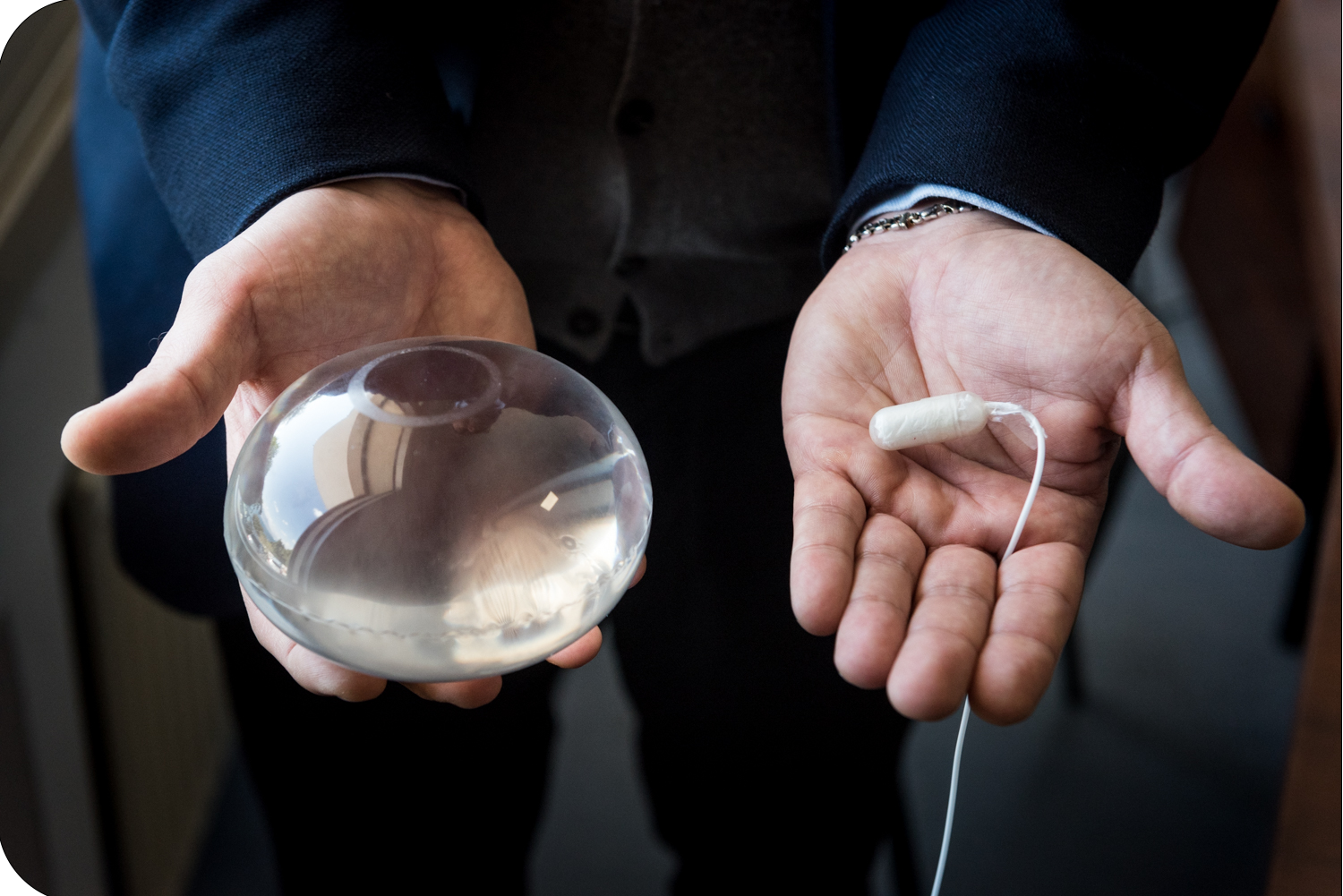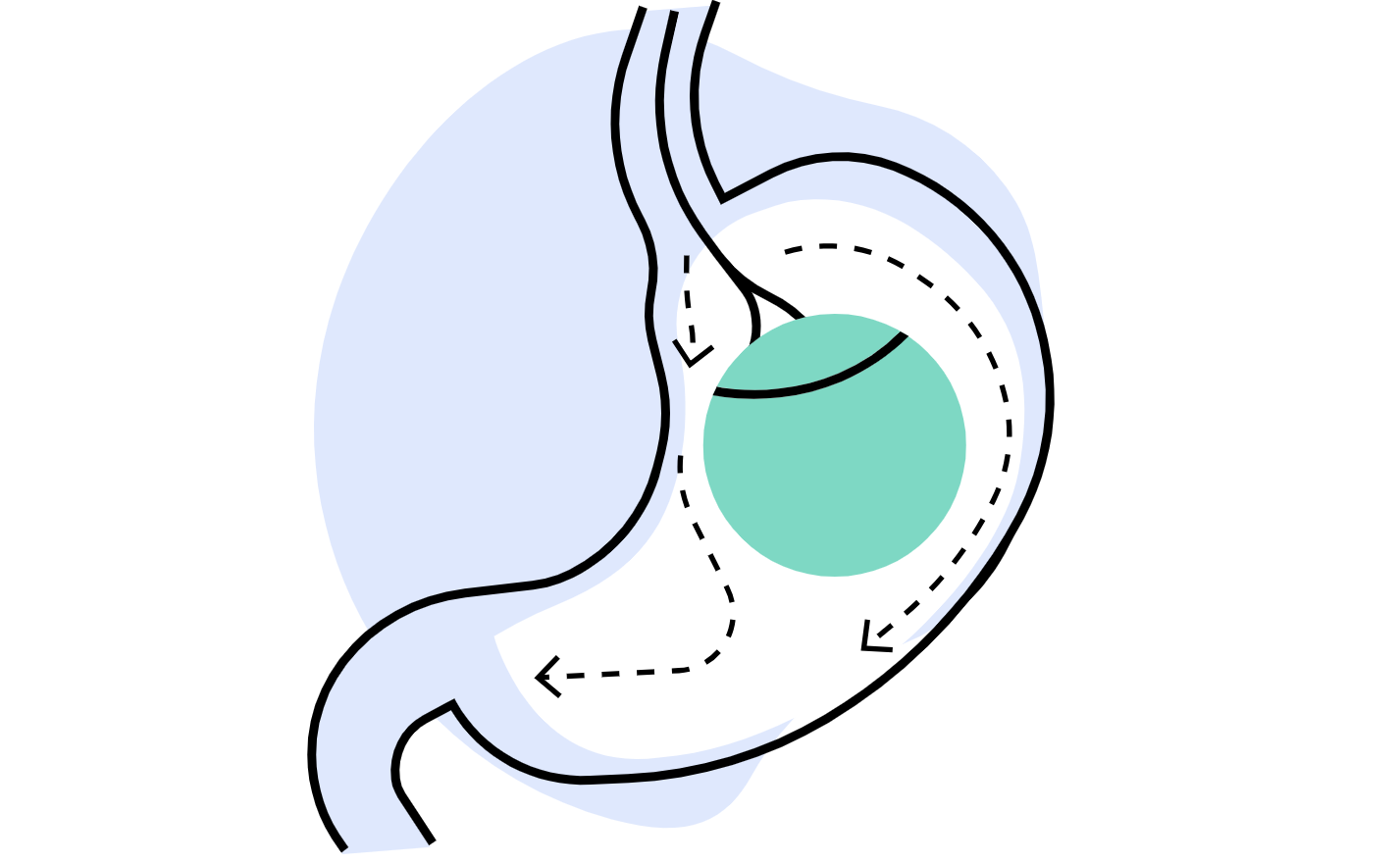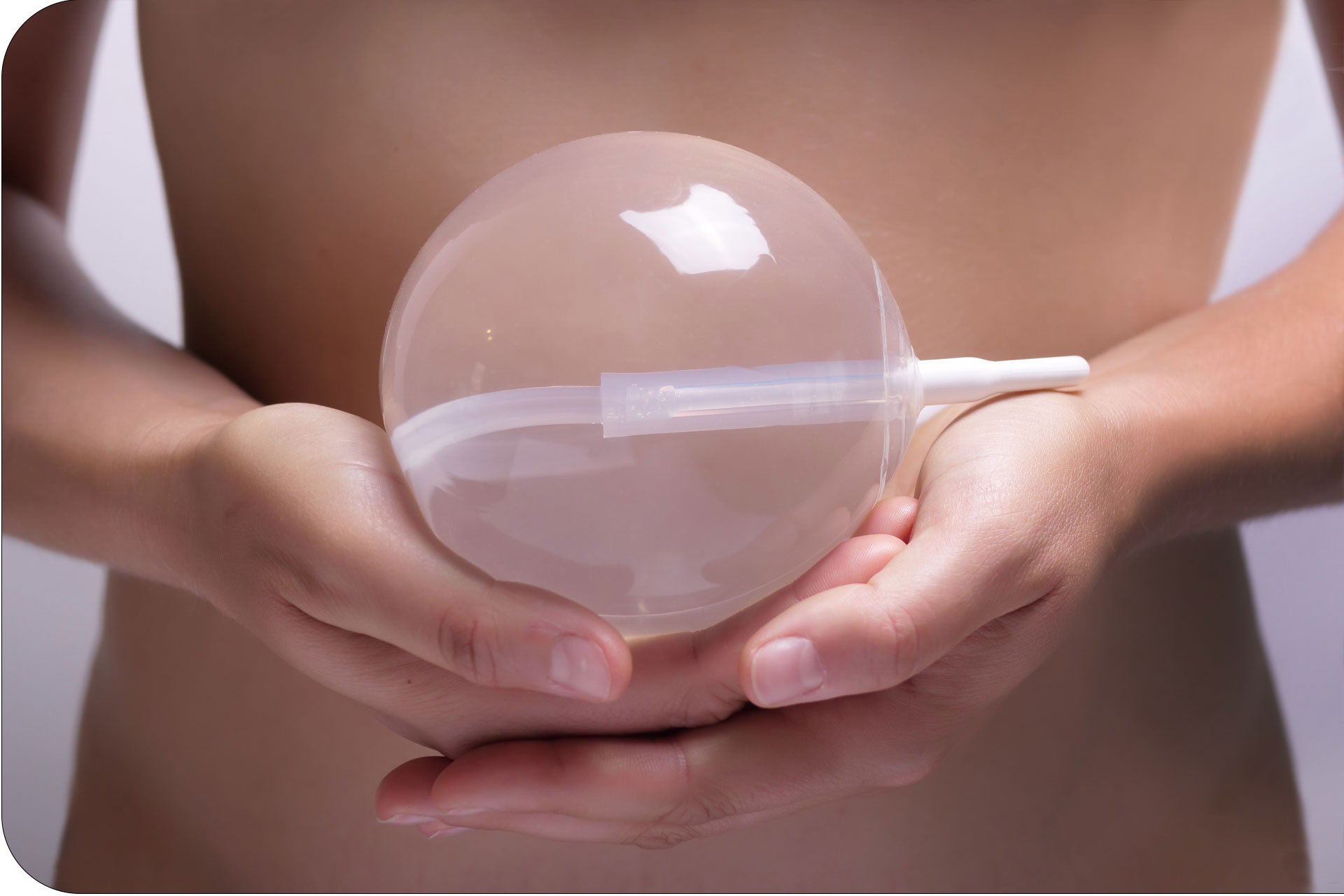Gastric Balloon
A gastric balloon, also known as an intragastric balloon, is a non-surgical weight loss procedure that involves placing a deflated silicone balloon into the stomach to create a feeling of fullness and reduce food intake. It is designed for individuals who may not qualify for or prefer to avoid invasive surgical procedures.

Here's an overview of how a gastric balloon is applied:
Pre-procedure evaluation:
Before the gastric balloon procedure, you will undergo a comprehensive evaluation by a healthcare professional. This evaluation typically includes a physical examination, medical history review, laboratory tests, and possibly imaging studies. The purpose of the evaluation is to determine your suitability for the procedure and identify any underlying medical conditions that may affect the safety or effectiveness of the treatment.
Balloon insertion:
The gastric balloon is typically inserted into the stomach during an endoscopic procedure. You will be sedated or placed under general anesthesia to ensure your comfort during the procedure.
Endoscopic insertion:
An endoscope, which is a flexible tube with a light and a camera at the end, is passed through your mouth and into your stomach. The endoscope allows the healthcare professional to visualize the stomach and guide the placement of the balloon.
Balloon placement:
Once the endoscope is in position, the deflated silicone balloon is inserted through the esophagus and into the stomach. The balloon is then filled with a sterile saline solution to achieve the desired size and shape. The amount of saline used varies depending on the specific balloon model and the individual's needs.
Balloon adjustment:
After the balloon is filled, the healthcare professional will ensure it is positioned correctly within the stomach. In some cases, the volume of the balloon may be adjusted to optimize its effectiveness in promoting weight loss.
Balloon retention period:
The gastric balloon remains in the stomach for a predetermined period, typically around six months. During this time, the balloon acts as a physical barrier, reducing the capacity of the stomach and creating a feeling of fullness. This helps control portion sizes and promotes weight loss.
Post-procedure care:
After the procedure, you will receive instructions on how to manage the balloon and adapt your diet and lifestyle. This may include following a specific diet plan, incorporating regular exercise, and attending follow-up appointments to monitor your progress and address any concerns.
Balloon removal:
At the end of the retention period (typically six months), the gastric balloon is removed. The removal procedure is similar to the initial insertion and is typically performed under sedation or general anesthesia. The deflated balloon is grasped with an endoscope and gently pulled out through the mouth.
Gastric balloons can be a temporary weight loss solution and are typically used as part of a comprehensive weight loss program that includes dietary and lifestyle modifications. The procedure is generally considered safe, but potential risks and complications, such as nausea, vomiting, balloon deflation, or balloon migration, should be discussed with your healthcare provider before undergoing the procedure.
Types of Gastric Balloon
1. Swallowable Gastric Balloon (Elipse)
A swallowable gastric balloon, also known as an ingestible gastric balloon, is a type of non-surgical weight loss device that can be swallowed without the need for an endoscopic procedure. Unlike traditional gastric balloons that require endoscopy for insertion and removal, the swallowable gastric balloon offers a less invasive alternative.

Here's an overview of how a swallowable gastric balloon typically works:
Balloon expansion:
Once the device reaches the stomach, it dissolves or opens up, releasing the deflated balloon. The balloon is then filled with a sterile saline solution or gas, such as air or carbon dioxide, through a thin tube connected to the device.
Expansion verification:
To ensure proper balloon placement and inflation, the device may include a connected sensor or imaging technology that confirms the correct positioning of the balloon within the stomach.
Balloon retention period:
The balloon remains in the stomach for a predetermined period, typically for 4-5 months. During this time, the balloon occupies space in the stomach, promoting a feeling of fullness and reducing food intake.
Monitoring and follow-up:
Throughout the retention period, you will have regular follow-up appointments with your healthcare provider to monitor your progress, discuss any concerns, and receive guidance on diet and lifestyle modifications.
Balloon removal:
At the end of the retention period, the balloon is typically deflated and removed through a non-surgical procedure. The deflated balloon is passed through the gastrointestinal tract and eliminated naturally.
Swallowable gastric balloons offer the advantage of being a less invasive option compared to traditional gastric balloons. They eliminate the need for endoscopy for both insertion and removal, which can make the procedure more accessible and convenient for some individuals. However, it's important to note that the specific details and requirements of the swallowable gastric balloon may vary depending on the manufacturer and the guidelines followed by your healthcare provider. It's recommended to consult with a qualified healthcare professional who can provide you with detailed information and determine if a swallowable gastric balloon is a suitable option for your specific circumstances.

2. 6 Months Gastric Balloon
A 6-month gastric balloon refers to a type of weight loss device that is designed to remain in the stomach for a duration of approximately six months. It is a temporary non-surgical intervention aimed at assisting individuals with weight loss efforts.
Here's an overview of the 6-month gastric balloon procedure:
Insertion:
The deflated balloon is typically placed in the stomach using an endoscopic procedure. During this procedure, a thin tube with an attached deflated balloon is passed through the mouth and into the stomach. Once in position, the balloon is filled with a sterile saline solution or gas to achieve the desired size.
Balloon expansion:
After the balloon is filled, it occupies space in the stomach, creating a feeling of fullness and reducing hunger. The expanded balloon helps restrict the amount of food that can be consumed, facilitating portion control and promoting weight loss.
Post-procedure care:
Following the placement of the gastric balloon, individuals typically receive guidance from their healthcare providers on diet, nutrition, and lifestyle modifications. This may include adopting a specific diet plan, incorporating regular physical activity, and attending regular follow-up appointments for monitoring and support.
Balloon removal:
At the end of the approximately six-month period, the gastric balloon is removed. The removal procedure is similar to the insertion process and is usually performed through an endoscopic procedure. The deflated balloon is grasped with an endoscope and gently pulled out through the mouth.
The 6-month gastric balloon is designed to be a temporary weight loss solution, offering individuals support and motivation during the initial phase of their weight loss journey. It serves as a tool to facilitate portion control, promote lifestyle changes, and establish healthier eating habits. It is important to note that the balloon's effectiveness depends on individual adherence to dietary and lifestyle recommendations during its placement.
As with any medical procedure, there are potential risks and side effects associated with gastric balloon placement, such as nausea, vomiting, and stomach discomfort. It is crucial to consult with a qualified healthcare professional to determine if a 6-month gastric balloon is an appropriate option for your specific circumstances and weight loss goals. They will provide detailed information, assess your suitability for the procedure, and guide you through the process.
3. 1 Year Adjustable Gastric Balloon (Spatz)
The 1-year adjustable balloon is a type of gastric balloon designed to aid in weight loss over a one-year period. It is a variation of the traditional saline-filled gastric balloon with an additional feature that allows for adjustment during the treatment period.
Here's how the 1-year adjustable balloon typically works:

Insertion:
The deflated balloon is inserted into the stomach through an endoscopic procedure. It is typically placed while you are under sedation or general anesthesia.
Inflation:
Once the balloon is positioned correctly in the stomach, it is filled with a sterile saline solution. The initial volume of the balloon is determined by the healthcare professional based on your individual needs and stomach capacity.
Adjustment:
The 1-year adjustable balloon has a small filling port or valve connected to the balloon. This port allows for adjustments to be made without the need for additional endoscopic procedures. Throughout the one-year treatment period, the balloon volume can be increased or decreased by adding or removing saline through the filling port.
Weight loss period:
The balloon remains in the stomach for approximately one year. During this time, it helps reduce the capacity of the stomach, leading to a feeling of fullness and reduced food intake. The gradual weight loss achieved through the balloon-assisted portion control supports lifestyle changes and long-term weight management.
Follow-up care:
Regular follow-up appointments are scheduled with your healthcare provider to monitor progress, discuss any concerns or adjustments needed, and provide guidance on dietary and lifestyle modifications.
Removal:
At the end of the one-year treatment period, the 1-year adjustable balloon is removed through an endoscopic procedure similar to the initial insertion. The deflated balloon is gently grasped with an endoscope and then extracted from the stomach through the mouth
The 1-year adjustable balloon offers the advantage of allowing healthcare professionals to optimize the balloon volume based on your progress and individual needs. By adjusting the balloon volume, they can fine-tune the level of satiety and portion control throughout the treatment period.
Benefits of Gastric Balloon Procedure:
Non-Surgical and Reversible:
The Gastric Balloon Procedure is a non-surgical intervention that does not require any incisions or permanent alterations to the stomach. The balloon can be removed after a designated period, allowing you to explore other weight loss options if desired.
Reduced Appetite and Portion Control:
The balloon occupies space in the stomach, creating a sensation of fullness and reducing hunger. This helps you consume smaller portions and make healthier food choices, leading to weight loss.
Short Recovery Time:
Since it is a non-surgical procedure, the Gastric Balloon Procedure typically requires minimal downtime, allowing you to resume your daily activities quickly.
How much weight can be lost with gastric balloon?
The amount of weight lost with a gastric balloon can vary widely depending on several factors, including individual characteristics, adherence to dietary and lifestyle changes, and the specific type of gastric balloon used. On average, individuals undergoing gastric balloon treatment can expect to lose around 10% to 30% of their total body weight.
It's important to note that the gastric balloon is not a standalone weight loss solution. It is typically part of a comprehensive weight management program that includes dietary modifications, regular exercise, and behavior changes. The balloon is designed to aid in portion control by creating a feeling of fullness and reducing hunger, which can contribute to calorie restriction and weight loss.
While results can vary, many individuals experience significant weight loss during the initial six-month period when the gastric balloon is in place. However, it's essential to understand that long-term success depends on maintaining healthy habits and lifestyle changes even after the balloon is removed. The weight loss achieved with the gastric balloon can serve as a jumpstart or motivation for continued progress toward achieving and maintaining a healthy weight.
It's important to consult with a healthcare professional who specializes in weight management and can provide personalized guidance. They will evaluate your specific circumstances, discuss realistic weight loss expectations, and help you develop a comprehensive plan that includes the gastric balloon and supportive measures for long-term success.
Which Gastric Balloon is suitable for me?
The suitability of a specific gastric balloon for an individual depends on various factors, including their overall health, body mass index (BMI), weight loss goals, medical history, and preferences. The selection of the most suitable gastric balloon is typically determined through a comprehensive evaluation and consultation with a healthcare professional specializing in weight management.
Is it possible to apply gastric balloon after gastric sleeve surgery?
The application of a gastric balloon after gastric sleeve surgery is neither recommended nor commonly performed. Here's why:
Stomach size reduction:
Gastric sleeve surgery, involves the permanent removal of a large portion of the stomach, resulting in a smaller stomach pouch. This procedure is designed to significantly reduce stomach capacity and restrict the amount of food that can be consumed. The goal is to promote weight loss by creating a feeling of fullness with smaller meal portions.
Limited space for additional devices:
After gastric sleeve surgery, the remaining stomach is significantly smaller, and there may be limited space available to accommodate a gastric balloon. The stomach pouch created during the sleeve gastrectomy procedure is already small, and inserting a gastric balloon may not be feasible or comfortable for the patient.
Potential complications:
Combining a gastric balloon with gastric sleeve surgery may increase the risk of complications. The presence of a gastric balloon within the stomach after gastric sleeve surgery could potentially cause irritation, obstruction, or discomfort. It may also interfere with the healing process or alter the anatomical changes made during the sleeve gastrectomy.
Different weight loss mechanisms:
Gastric sleeve surgery and gastric balloon function through different mechanisms. Gastric sleeve surgery permanently reduces stomach size, while a gastric balloon is a temporary device that aids in weight loss by promoting a feeling of fullness. Combining these two procedures may not provide additional benefits in terms of weight loss and could introduce unnecessary risks.
It's important to consult with a qualified healthcare professional to discuss your specific situation and weight loss goals. They will assess your individual circumstances, provide personalized recommendations, and guide you on the most suitable treatment options. However, in general, gastric balloon placement after gastric sleeve surgery is not a common practice due to the reasons mentioned above.
Why Choose Elan Tour On Time for Gastric Sleeve Surgery or Gastric Balloon Procedure?
At Elan Tour On Time, we understand the importance of comprehensive care and support throughout your weight loss journey. When you choose us for your Gastric Sleeve Surgery or Gastric Balloon Procedure, you can expect:
Access to experienced bariatric surgeons who specialize in weight loss procedures.
State-of-the-art medical facilities equipped with advanced technology.
Personalized pre-operative evaluations and consultations to determine the best treatment plan for your unique needs.
Assistance with travel arrangements, accommodation, and post-operative care.
Ongoing support and guidance from a dedicated team of medical professionals.
Take the first step towards a healthier, happier you with Gastric Sleeve Surgery or the Gastric Balloon Procedure at Elan Tour On Time. Contact us today to schedule a consultation and embark on your transformative weight loss journey.
